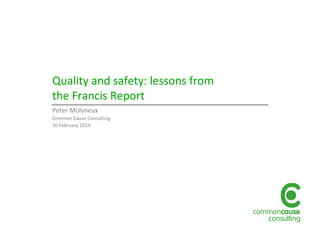
Quality and safety: lessons from the Francis Report
- 1. Quality and safety: lessons from the Francis Report Peter Molyneux Common Cause Consulting 10 February 2014
- 3. • No NED had current or previous clinical experience • NED discouraged to get involved in “operational matters” • Major organizational changes not discussed by the Board • NEDs accepted reassurance rather than assurance • Lack of soft intelligence or testing of reassurance • Lack of clear clinical engagement and leadership • Lack of tracking of action plans • No benchmarking • Foundation status and financial targets a distraction from other issues Mid-Staffordshire
- 4. Survey of Board members of housing associations, 2013: •Quality management focused on buildings and asset management •Quality reports focus on KPIs for arrears, planned maintenance, repairs, staffing levels, mandatory training, etc •Quality management systems used a combination of user- generated feedback, announced / unannounced inspections, and numbers accessing training and employment •Quality assurance systems less developed •Very few board members felt they received proper assurance around quality and safety of care and support services that were provided Quality assurance in housing associations
- 5. “Whilst quality management systems might be effective there is little assurance being given and hence not inconsiderable reputational risk.” Quality assurance in housing associations
- 6. • Winterbourne View and Mid-Staffs have undermined public confidence in health and care system • Francis Report shows failings not restricted to any single sector, or type of provider • Government proposals have significant implications for HA boards, and how they discharge their responsibility as stewards of organisational reputation • Combined with changes to CQC regulatory model, creates new responsibilities for Boards, and new expectations from stakeholders • Introduction of fundamental standards, clear guidance combined with an enhanced role for HSE Changing regulatory environment
- 7. • Set of fundamental standards as part of CQC registration, with a clear baseline below which care must never fall, combined with tougher sanctions against providers that do not meet these standards • All directors of providers registered with CQC will be required to meet a new ‘fit and proper person’ test • CQC will consider the role of the board and individual directors in any service failure – with the power to insist on their removal or to prosecute in the case of serious failure Changing regulatory environment / continued
- 8. • New statutory duty of candour: providers required to make sure staff are open with service users and their families if they believe there have been failings in treatment or care, and to provide an explanation for it • An improved and strengthened inspection regime will focus on a risk based approach using inspection teams that are more experienced in the delivery and scrutiny of frontline services Changing regulatory environment / continued
- 10. 
- 11. Performance against quality KPI •Compliance with regulatory requirements and standards •Key risk areas and mitigations •Trends and areas for improvement •Summary of any external assessments / reports / inspection in period Incident management •Narrative, trends and areas for improvements Quality report
- 12. Workforce •Vacancy rates, turnover, bank and agency, etc •Staff feedback summary •Staff engagement activity Customer involvement •Internally commissioned surveys – customer surveys, real- time, any-time •Announced and unannounced visits – discovery visits, spot checks, customer audits, etc •Compliments, complaints and MP enquiries Quality report / continued
- 13. • High level document for use by the Board • Sets out strategic risks which threaten the organisation’s strategic objectives • Assesses controls and gaps in these • Records means of assurance and gaps • Assigns responsibility, timing and monitoring for mitigating actions on controls and assurances Board assurance framework
- 14. 1. Measuring outcomes that matter most to service users 2. Ensuring the organisation has identified the strategic risks to the delivery of its objectives and desired outcomes, and is aware of gaps in assurance 3. Demonstrating triangulation of different types of data and use independent sources of assurance 4. Scrutinising quality and safety, and asking the right questions: vital to ensuring there is a culture that challenges the normalisation of variance from required standards 5. Boards are informed about performance against key quality indicators, risks to delivery of quality 6. Risks to reputation given equal weight to financial risks Six-step pathway to quality assurance